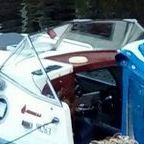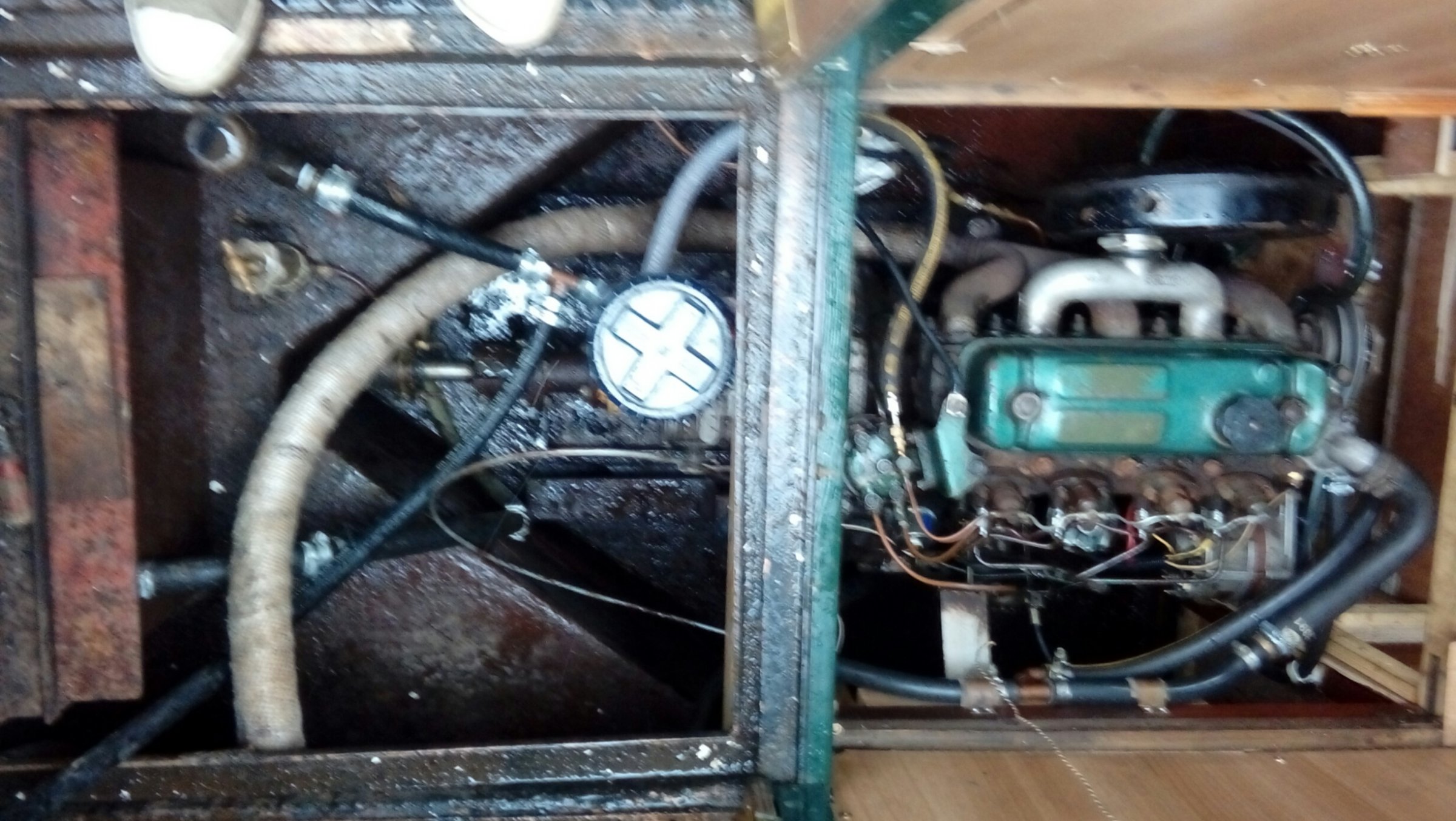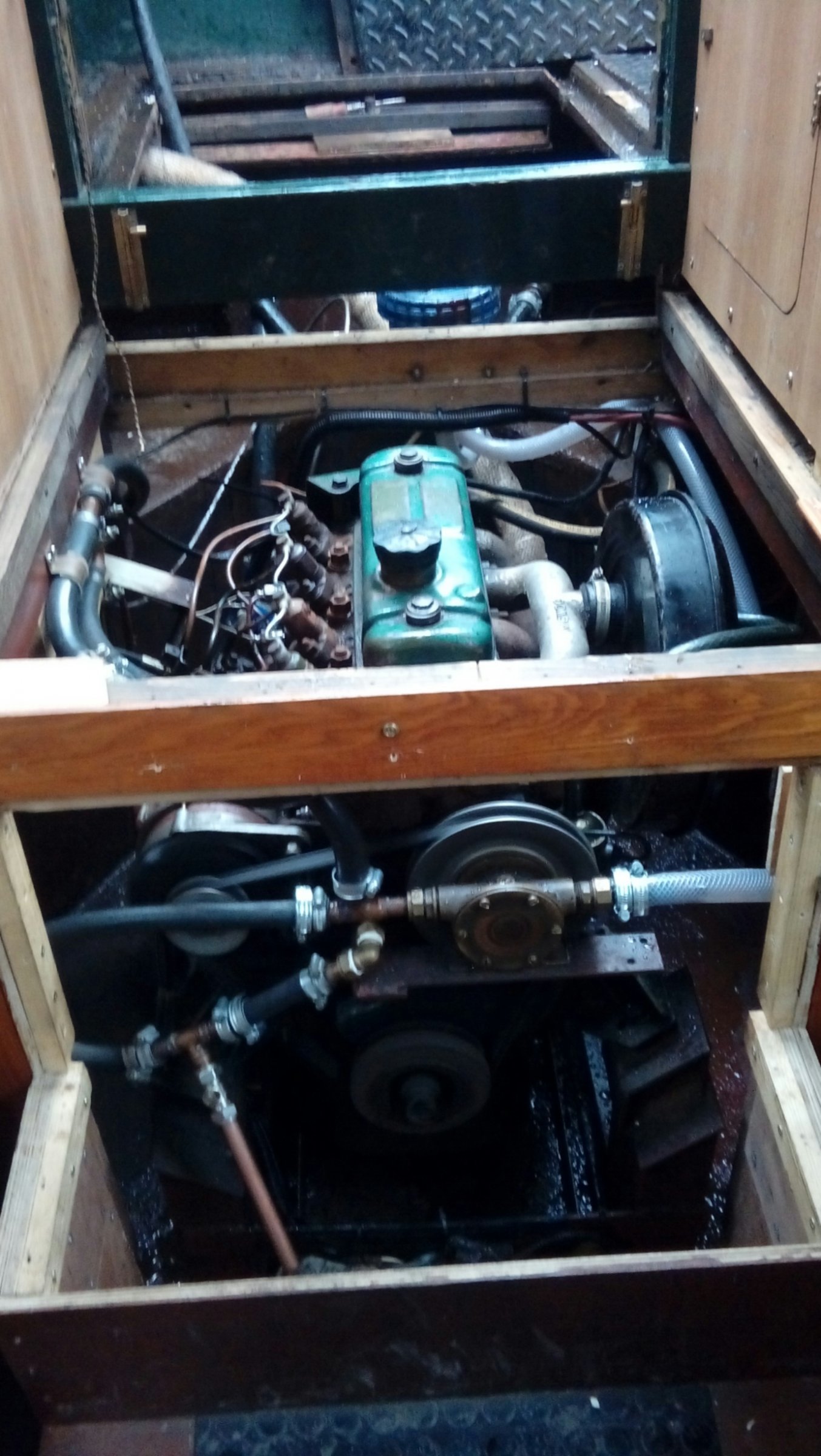-
Posts
2,234 -
Joined
-
Last visited
Content Type
Profiles
Forums
Events
Gallery
Blogs
Store
Everything posted by Mad Harold
-
Some pictures of my engine installation.It's direct raw water cooled and I have removed the 82 deg thermostat replacing it with a 74 deg one. Running the engine today,the temperature barely reached 60 deg after 1 hours running,I was going to take it up the cut to see if it would rise to 74 deg but the weather was 'orrible,rain and sleet.Although the engine had a service last September,as well as changing the thermostat,I gave the mechanics a dose of looking at,syphoned a pint or so out of the tank,[it was clear],drained the gascolator [no water in it] and cleaned the muck from under the filter screen in the fuel pump.With the weather the way it was,and me stinking of diesel,and feeling fed up by this time,I retired hurt and went home. My boat at the moment is on the Peak Forest Canal,and my home mooring is in Huddersfield.If and when the Marple lock flight opens,it is a four or five day trip,but if I have to go the long way round,[Macc,TandM,Bridgewater] it is likely to be ten to twelve days.This is why I worry about my engine,I would not be a happy tiger if the donkey handed it's dinner pail in on the way home. Thanks to everyone for their advice.
-
Is this true? If so CRT can't possibly maintain our canals. Some time ago, I sent an e mail to my local MP expressing concern about the low water levels in the Huddersfield Narrow.She did contact CRT and was given the reasons; leaks in the canal wall,a finite water supply in the feeder reservoirs,and leaking locks.CRT said they were working on these problems ASAP. I think the question of funding the CRT needs to be raised with our elected representatives,and perhaps when they realise that it's not just boater's votes that are at stake here,but countless thousands of others [dog walkers,joggers,ramblers,fishers,and others who enjoy the canals] then serious questions may be asked of the government about funding this wonderful leisure resource.
-
Have been looking closely at my cooling system, and the more I look, the more puzzled I become. A direct raw water cooling system seems very rare and mine doesn't look right somehow. I have been asking several boat owners if they have a direct raw water system to ask if I could have a look,but everyone I asked had either skin tanks or heat exchanger cooling. Happily the boat moored next door but one was direct raw water cooled.[I never thought of asking there] The owners kindly allowed me to have good nose around their engine room,and I found a few differences to mine. First,their water pump is the standard BMC pump in the front of the engine.Mine has a Jabscoe pump mounted on a bracket on a blanking plate covering the hole where the original pump was.Theirs had two water inlets connected to the water filter,mine has only one.The water bypass on this installation comes out of the cylinder head,on mine,it is in the pipe leading to the engine. On heat exchanger cooling systems I have looked at,the Jabscoe pump is driven off what looks like a smaller diameter pulley bolted to the engine pulley.On mine it is driven by the engine pulley,and is probably being driven too fast. I am guessing that my boat has not always been direct raw water cooled and was probably heat exchanger cooled at some time,because with direct water cooling there is no need for an expensive Jabscoe pump, but something went wrong,possibly a corroded heat exchanger,and to save money a previous owner dispensed with the engine driven water pump and simply plugged the raw water pipe from the Jabscoe into the engine,removing the small pulley and using the engine pulley to drive the Jabscoe possibly thinking that the engine would need a greater flow of water than the heat exchanger.Even at tickover there is a steady stream of water from the outlet,squirting about three inches and at cruise about six inches.The more I looked at my system the more "Fred In a Shed" If I may quote Tony Brooks it looked. Direct raw water cooling is undesirable for all the reasons given by all the contributors to this thread [localised overheating,scale build up,sediment build up] so I will at some point convert to heat exchanger cooling. Nick at TW Marine Furness Vale showed me some heat exchangers,on the computer,and one I think he said it was a Polar,looks compact enough to fit easily.I will also need a standard water pump,they come in three impeller sizes,60mm 70mm and 74mm,but I don't know yet what size was fitted to mine,untill I remove the Jabscoe and blanking plate. Could anyone tell me what the correct gearing is for a Jabscoe pump ?[ What size pulley on the pump to what size pulley on the engine?] Thank you all for giving me the benefit of your knowledge and experience.
-
Many thanks Tony,a very clear explanation
-
My boat has direct raw water cooling and when I bought it I noticed the temperature needle hardly moved off it's stop.On investigating I found that there was no thermostat fitted.I fitted an 82 degree thermostat and now the engine runs at 80 degrees. I have posted on another thread and was advised [by Mr. Brooks] that this is too hot for a direct raw water cooled engine,but ok for a heat exchanger cooled engine. I can only think that this is because with a heat exchanger cooled engine the cooling water entering the engine will already be hot,but with direct raw water cooling it will be cold causing a thermal shock. Is this a correct assumption to make? There is a 74 degree thermostat listed by ASAP supplies,but I am not sure if 8 degrees will make much difference to the chances of a cracked cylinder head. Would I be better off running without a thermostat ? as the boat was when I bought it.
-
Thank you Mr.Brooks for taking the time to answer. The thermostat I fitted is described by ASAP supplies as "without shutoff"I assume that means it will not fully close in the event of failure,thereby stopping all cooling water circulating. ASAP supplies only list two thermostats for the BMC 1500,82 degrees and 74 degrees. It is definitely direct raw water cooled. I take your point about confusing the original query.
-
You've got me worried now. I'm beginning to wish I hadn't posted! How many core plugs are there ? I've looked at the manual online,and although it's not very clear It appears to show three at either side.I can't see any behind the backplate. Yes, the raw water cooling is thermostatically controlled,with an 82degree non shutoff thermostat. Many thanks for your replies.
-
Thank you for the reply,but as far as I am aware,my boat has had raw water cooling from new. [1978]. Core plugs are £3-56 from ASAP supplies,and a thermostat without shutoff is£5. There are drawbacks to raw water cooling,but in my humble opinion,these are outweighed by the simplicity of it.
-
If the cap of the filter is lower than the waterline,is there a danger that if the seal is not good or there is a leak somewhere in the system,that water could syphon in? I am also rather baffled by the complexity of this cooling system,[me not coming from a boating background] but having many years of fettling all types of engines [motorbike,car,dumper,aircraft,and lately,outboards.] Surely Dean would be better off scrapping this system and installing a simple raw water cooling system.[Water in,around the engine,and out] You can call me a nitwit if you like Mr.Brooks,because I have overlooked this,this,and this,but the engine on my boat [BMC 1500] is cooled in this way,and in the time I have owned it ,has been quite satisfactory.
-
Lighten and simplicate. [Attributed to Sir Geoffrey De Haviland,of Tiger Moth and Mosquito fame]
-
May I describe the cooling system on my boat,it may give you some guidance although I will defer to more experienced boaters. BMC 1500 cooled directly by canal water. Seacock in the swim plate with home made strainer in it [1ft of 15mm copper pipe with lots of 1/4inch holes ] goes to standard type water filter,[plastic with see through top].Then to foot mounted water pump which looks the same as yours.The engine water pump has been removed and a blanking plate with a water inlet has been fitted.The outlet pipe from the water pump goes to the blanking plate water inlet and has a "T" in it for the bypass.Bypass has a "T" in it connected to the thermostat pipe and then to the water outlet on the side of the hull. Don't know how to post photos but the system is very simple,and does away with the need for heat exchangers,skin tanks etc. The only downside is that it has to be drained if the boat is to be left in below zero temperatures,but I have fitted a drain valve in the feed side of the pump so this is easily done. The temperature needle has never exceeded 80 degrees even when giving the engine some "pastie"
-
My boat too has a BMC 1500 but it looks nothing like your installation.Yours looks to be a "one off"and to be honest looks a bit of a plumbers nightmare. I have had my engine overheat,and I found that the raw water inlet was blocked with leaves.Also there should be a water filter in the water inlet line,and this should be checked. A long shot but,if your boat has been standing for a while,the water inlet seacock may have been turned off.
-
Having owned a Norman GRP cruiser,and now have a 30ft steel narrowboat,I would like to give my opinion. There were several features of the Norman that I didn't like; crampted cabin,awkward to get in and out of,difficult to keep to the middle of the canal even on calm days,and if a bit of breeze blowing,horrible. Most GRP cruisers have a semi planing hull,and although they are directionally stable at speeds above about 6-7kts,at 3-4mph they are not.I fitted a rudder to my outboard,and although it improved steering response,it did nothing for directional stability.Adding ballast helped a bit,but in a small cruiser it takes up storage space. Most outboard powered boats need at least 3ft of water for the engine,[not always the case on our canals]. Some of the locks around here only have a 7ft entrance,so it was necessary to lift the fenders when locking,resulting in scratches to the hull.A regular job was filling all the scars and after the first few times I didn't bother sanding them down because it would have to be done again after the next trip. My narrow boat on the other hand is roomy,I can stand upright inside,it is easy to get on and off,and most importantly for me,it steers properly,I feel now that I am in charge of the boat instead of the other way around.The prop on a narrow boat spins within the confines of the hull,so although the boat may scrape the bottom,the prop should be ok, The biggest factor in deciding between steel and GRP is price. For the price of a fairly rough steel boat you could probably buy two really nice GRP boats. Although my Norman was cramped,I have a pal who lives aboard a Buckingham 22,and it seems roomier than the Norman.His boat has shore power and electric heating so is quite comfortable. He is quite happy.
-
A woman who can't steer the boat,won't operate locks,can't cook,and doesn't like sex.
-

HELP! I dropped a twig in my fuel tank!
Mad Harold replied to The Boat Studio's topic in Boat Building & Maintenance
I don't agree. Foreign objects and crap in the tank can cause engine stoppages probably at the worst time.Like when you are close to a weir! Its better out than in [as the actress said to the bishop] -

HELP! I dropped a twig in my fuel tank!
Mad Harold replied to The Boat Studio's topic in Boat Building & Maintenance
Before taking up boating,I was told by several people that boaters were mad,divorced and alcoholic.I didn't believe them,untill now. C'mon fellas, a serious question was asked by a new worried boater. Have a heart. -
Water in my engine bay [cruiser stern] is mainly rain water,added too with a minor leak from the engine cooling system.It amounts to less than an inch a month depending on the amount of rainfall. It has not so far activated the auto bilge pump [yes,it is working] as I bought a cheapo pump [the sort for changing engine oil without the need to drain the sump] this type works by creating a vacuum in a container so the pump itself doesn't get muck in it.The last few mm of water that the pump misses,can be mopped out with a sponge. Once the engine bay is nice and dry,[deep joy] a piece of kitchen roll under the stern gland will indicate if the stern gland is leaking. I have been informed by the engineer at my mooring that tightening the grease tap will not cure a leaking gland.It needs adjusting or re-packing. Pumping out the engine bay is just one more "houskeeping" job to add to the list.
-
Quite right The Huddersfield [shallow] Narrow runs through some of the best scenery anywhere.Unfortunately It frequently suffers from low water levels due to several factors.I recently wrote to the Colne Valley's M.P to ask if this could be raised with the CRT.The answer was; significant leaks from the canal walls and locks,and a finite amount of water in the canal feeder reservoirs.CRT say they are aware of the problem and are doing major work on the canal banks to try to address this. Also what is generally not known,is that Huddersfield University takes water from the canal for it's air conditioning systems,and puts it back in the pound below where it takes it from which doesn't help. Having lived and worked in the Colne Valley for over over forty years the Huddersfield Narrow is my local and favourite waterway despite the zillions of locks and low water.Every boater ought to experience the Standedge Tunnel at least once.
-

Dutch cruiser constant cruise around london
Mad Harold replied to Tara1234's topic in New to Boating?
Google Norman boat owners forum[NBAS] Loads of information and advice on Norman boat ownership. -

How to tackle the damp???? Any ideas??? Thanx
Mad Harold replied to lucyboatgirl's topic in New to Boating?
I had a 20ft Norman cruiser and damp was a problem when I first got it. There were several causes.Leaking windows,leaking canopy,leaking deck fittings,water in the bilges,and also a roof leak.The Norman has a double skin cabin roof and water from a roof leak can run anywhere in the boat. Investigation with a helper and a hose should help you track down most leaks,but be aware that where the water is coming in on the inside is not always where it is entering on the outside.Also it can take some time for the water to percolate through. It can be a painstaking process,finding leaks,but worth the effort. To minimise condensation [when all leaks have been fixed] line the cabin inside with cheap thin carpet sticking it on with Evostick and ensure that the bilges are always dry. -
Thank you Kedian.I have just looked at your website and found that most of my questions about overplating have been answered. I only wish that I had been aware of Canal net and your website BEFORE I bought my boat. Many thanks,
-
Many thanks to Ratkatcher, David Mack, and Allan for your replies.Together with the other contributers on the subject of overplating,I am now much clearer on the pros and cons of this procedure.
-
Hi Allan, When you had your boats sides overplated,how much internal stripping out [if any] did you have to do? I have been told by some people that the heat from welding the outside can damage or even set fire to interior fittings.I am relatively new to steel boats and have listened to lots of advice [usually conflicting] from more experienced boaters,so I would like to get it from the horse's mouth as it were. Thanks in advance, Terry.
-
Have just been on NBAS cos I used to have a Norman,and still have a soft spot for them,and I noted that you know about it already. Apologies.
-
Google N.B.A.S. [Norman boat appreciation society] You will find tons of information on Norman boats.









